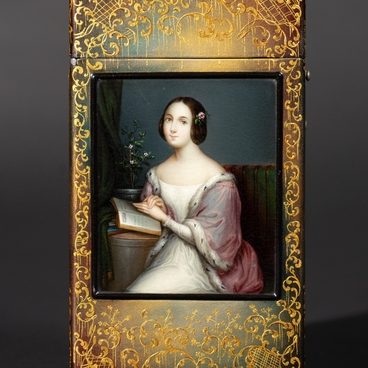In the second half of the 19th century, scenes inspired by folk life became especially popular in Russian lacquer painting: troikas (carriage drawn by three horses), festivities, scenes from boyar life (boyars were highest rank members of Russian feudal nobility). Masters created such miniatures based on reproductions of paintings by prominent Russian artists Pyotr Gruzinsky, Aleksander Orłowski, Konstantin Makovsky.
The box ‘They listen to the Bandurist’ is based on the painting of the same name by Konstantin Makovsky. Many artists copied his works due to colorfulness and detailed beautiful settings typical for his style.
The main character of the miniature is an elderly musician, he plays bandura (zither) and soulfully sings. Most likely, the hero performs slow poetic cants and spiritual psalms, which were often included in the repertoire of kobzars (as bandurists were traditionally called). Boyarinas and small children thoughtfully listen to him playing.
An ordinary genre scene turned into a visual illustration of old customs. Following Makovsky, the master miniaturist meticulously painted costumes of the characters, accessories, and household items: the red corner with icons, a wall cabinet with a towel behind the musician’s back, dishes on the table, trees behind a latticed window, a burning lamp behind the door.
The miniature is distinguished by the master’s great attention to detail: he carefully painted the boyar chambers down to the wallpaper pattern and ornament on the floor. In terms of its color scheme, contrasting colors of cold and warm tones made the box very elegant.
In the 19th century, several dozen factories and privately-owned lacquer workshops functioned in Russia. In the Moscow governorate, the main competitor of the Lukutin factory were the workshops of Osip Vishnyakov, which were located near Fedoskino in the villages of Ostashkovo and Sorokino.
The workshop in Ostashkovo was one of the largest of that time. In the 1860s, the owner of the workshop built two brick buildings there: one housed a forge for casting trays and an oven for drying products, the second was used by painters. In addition to six representatives of the Vishnyakov family, 43 hired artists worked there.
It is important to note that if the Lukutin miniatures were refined and designed for the discerning public, the Vishnyakov ones were easily understandable and fit the tastes of the common people: they were much closer to the bright decorativeness of folk painting.
The box ‘They listen to the Bandurist’ is based on the painting of the same name by Konstantin Makovsky. Many artists copied his works due to colorfulness and detailed beautiful settings typical for his style.
The main character of the miniature is an elderly musician, he plays bandura (zither) and soulfully sings. Most likely, the hero performs slow poetic cants and spiritual psalms, which were often included in the repertoire of kobzars (as bandurists were traditionally called). Boyarinas and small children thoughtfully listen to him playing.
An ordinary genre scene turned into a visual illustration of old customs. Following Makovsky, the master miniaturist meticulously painted costumes of the characters, accessories, and household items: the red corner with icons, a wall cabinet with a towel behind the musician’s back, dishes on the table, trees behind a latticed window, a burning lamp behind the door.
The miniature is distinguished by the master’s great attention to detail: he carefully painted the boyar chambers down to the wallpaper pattern and ornament on the floor. In terms of its color scheme, contrasting colors of cold and warm tones made the box very elegant.
In the 19th century, several dozen factories and privately-owned lacquer workshops functioned in Russia. In the Moscow governorate, the main competitor of the Lukutin factory were the workshops of Osip Vishnyakov, which were located near Fedoskino in the villages of Ostashkovo and Sorokino.
The workshop in Ostashkovo was one of the largest of that time. In the 1860s, the owner of the workshop built two brick buildings there: one housed a forge for casting trays and an oven for drying products, the second was used by painters. In addition to six representatives of the Vishnyakov family, 43 hired artists worked there.
It is important to note that if the Lukutin miniatures were refined and designed for the discerning public, the Vishnyakov ones were easily understandable and fit the tastes of the common people: they were much closer to the bright decorativeness of folk painting.



